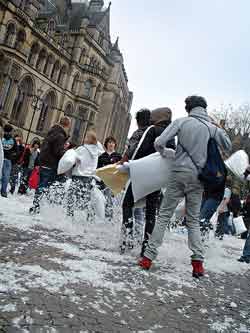Characteristics
Some call it performance art, some call it a movement, and others call it a group of crazy people. Webster's New Millennium Dictionary of English defines a flash mob as a group of people who organize on the Internet and then quickly assemble in a public place, do something bizarre, and disperse. There are sections on flash mob organization and execution for information on how to arrange and perform a flash mob, but what really makes a flash mob a flash mob?
The Surprise
A speedy and sudden assembly is important to any successful flash mob. Bystanders, anyone in the area not involved in the flash mob, should not suspect that anything is about to happen until the mob is in full swing. Jumping in early or anxious looks on mobbers faces could give it away before anything even happens.
The Act
What sets mobs apart from other performance art is the sheer randomness of the action. A good mob involves people doing something that wouldn’t normally do in that context, location, or anywhere else. Mobs like Manchester’s or Improv Everywhere’s freeze frames in a Sainsbury’s and Home Depot, respectively, is that no one expects shoppers to stop moving while browsing for milk, eggs or sheetrock.
Flash mobs should also take place in a short amount of time. Some can be as short as one or two minutes. Generally, flash mobs last fewer than 10 minutes.
Poignant or Pointless
Using flash mobs for the sake of random fun or using them to make a statement is a decision many flash mob organizers have to make. Flash mobs could, and have, been used for political protests, commercials and promotions, and just for fun.
Ultimately, organizers should look to the wishes of the mobbers. If a poignant mob is very unpopular, it might be best to try doing them just for fun.

 Pillow fight flash mob in Manchester, 2006
Pillow fight flash mob in Manchester, 2006